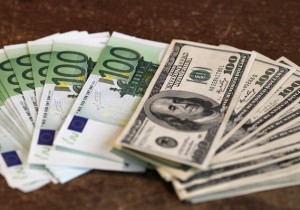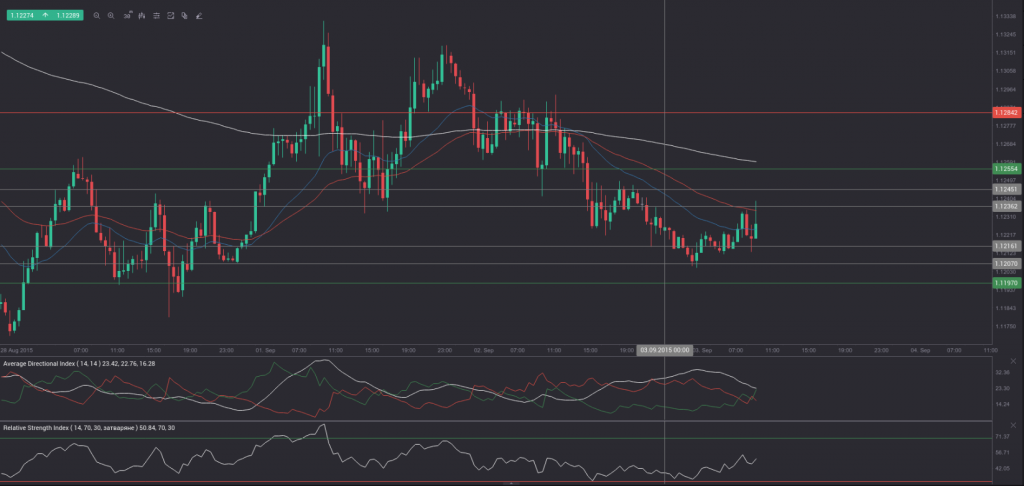 Yesterday’s trade saw EUR/USD within the range of 1.1214-1.1320. The pair closed at 1.1226, falling 0.82% on a daily basis, or the most considerable daily loss since August 26th, when it depreciated 1.75%.
Yesterday’s trade saw EUR/USD within the range of 1.1214-1.1320. The pair closed at 1.1226, falling 0.82% on a daily basis, or the most considerable daily loss since August 26th, when it depreciated 1.75%.
At 6:38 GMT today EUR/USD was down 0.03% for the day to trade at 1.1224. The pair attempted to test the range support level (S3), as it touched a daily low at 1.1205 in early Asian trade.
Today the cross may be influenced by a number of macroeconomic reports and events as listed below.
Fundamentals
Euro area
Services sector data by Markit
Activity in Italys sector of services probably expanded in August, with the corresponding PMI coming in at a reading of 53.0, as expected by experts, from 52.0 in the prior month. The latter has been the lowest PMI value since March, when the index stood at 51.6. If expectations were met, August would be the eighth successive month, when the PMI inhabited the area above 50.0. Markit Economics is expected to release the official data at 7:45 GMT.
Frances final services PMI probably confirmed the preliminary PMI reading of 51.8 in August, which was reported on August 21st. If so, this would be the lowest PMI level since April, when the gauge was reported at a final 51.4. It would also be the seventh consecutive month, when the PMI stood in the zone of expansion. In July the final services PMI was estimated at 52.0. The official reading is due out at 7:50 GMT.
The final reading of German services PMI probably confirmed the preliminary value for August, with the index coming in at 53.6, according to market expectations. If confirmed, this would be the lowest PMI reading since May, when the gauge was reported at 53.0. It would also be the 27th consecutive month, when the services PMI stood above the 50.0 level. In July the final services PMI was registered at 53.8. The index is based on data collected from a representative panel of more than 500 companies, operating in Germanys services sector, and gauges variables such as sales, employment, inventories and prices. Markit will release the official reading at 7:55 GMT.
The final services PMI in the Euro area probably also confirmed the preliminary value for August, with the index remaining at 54.3. If so, this would be the 25th straight month of activity expansion. In July the index came in at 54.0, according to final data, up from a preliminary reading of 53.8. The Purchasing Managers Index is based on a monthly survey, encompassing a sample of approximately 2 000 business entities, which represents private sector conditions in terms of new orders, output, employment, prices etc. National services data are included for Germany, France, Italy, Spain and the Republic of Ireland. Readings above the key level of 50.0 indicate optimism (increasing activity). Higher-than-expected values of any of the above mentioned PMIs would support demand for the common currency. The official reading for the Euro region is scheduled to be released at 8:00 GMT.
Retail Sales
Annualized retail sales in the Euro region as a whole probably rose 2.0% in July, according to the median forecast by experts, after in June sales climbed at a pace of 1.2%. If so, July would be the 19th consecutive period of growth. In monthly terms, retail sales probably increased 0.6% during July, following a 0.6% drop in June. This is a short-term indicator, which provides key information about consumer spending trend on a national scale. In case the index of retail sales rose at a faster-than-projected pace, this would have a moderate bullish effect on the euro. Eurostat is expected to publish the official data at 9:00 GMT.
ECB decision on policy
At 11:45 GMT the European Central Bank (ECB) is to announce its decision in regard to borrowing costs. The median estimate by experts suggests that the central bank will probably leave its benchmark interest rate intact at the record low level of 0.05% at the policy meeting today. The bank last reduced the refinancing rate by 10 basis points to the current 0.05% at the September 4th 2014 meeting.
At its meeting on July 16th the central bank kept the marginal lending facility intact at 0.30% and the deposit facility at -0.20%. In March the bank initiated purchasing public and private sector assets worth 60 billion euros a month.
According to extracts from the Introductory statement to the press conference, offered by ECB President, Mario Draghi: ”As explained on previous occasions, our monthly asset purchases of €60 billion are intended to run until the end of September 2016 and, in any case, until we see a sustained adjustment in the path of inflation that is consistent with our aim of achieving inflation rates below, but close to, 2% over the medium term.”
”Recent developments in financial markets, which partly reflect greater uncertainty, have not changed the Governing Council’s assessment of a broadening of the euro area’s economic recovery and a gradual increase in inflation rates over the coming years. The ECB’s monetary policy stance remains accommodative and market-based inflation expectations have, on balance, stabilized or recovered further since our meeting in early June. The latest information also remains consistent with a continued pass-through of our monetary policy measures to the cost and availability of credit for firms and households.”
”…we expect the economic recovery to broaden further. Domestic demand should be further supported by our monetary policy measures and their favourable impact on financial conditions, as well as by the progress made with fiscal consolidation and structural reforms. Moreover, the recent decline in oil prices should provide additional support for households’ real disposable income and corporate profitability and, therefore, private consumption and investment.”
”The downside risks surrounding the economic outlook for the euro area have generally been contained as a result of our monetary policy decisions, as well as oil price and exchange rate developments.”
Short-term interest rates are of utmost importance for the valuation of national currencies. In case the European Central Bank is dovish about inflationary pressure and overall economic activity in the Euro area and, thus, leaves interest rates intact, this will generally have a bearish effect on the common currency.
The interest rate decision is to be followed by the press conference with ECB President Mario Draghi, during which volatility of euro crosses usually heightens. In case Draghi offers a more hawkish tone, the euro will usually receive support, while a more dovish tone will have a bearish effect on the currency. The press conference is scheduled at 12:30 GMT.
United States
Initial, Continuing Jobless Claims
The number of people in the United States, who filed for unemployment assistance for the first time during the business week ended on August 28th, probably rose to 275 000, according to market expectations, from 271 000 in the prior week. The latter has been the lowest number of claims since the business week ended on July 31st, when 270 000 claims were reported.
The 4-week moving average, an indicator lacking seasonal effects, was 272 500, marking an increase of 1 000 compared to the preceding weeks unrevised average.
The business week, which ended on August 21st has been the 25th consecutive week, when jobless claims stood below the 300 000 threshold. This continues to support the case labor market conditions in the country follow the path of improvement. Claims are usually volatile during the summer period, as automakers shut assembly plants for annual retooling and also due to school vacations.
Initial jobless claims number is a short-term indicator, reflecting lay-offs in the country. In case the number of claims met expectations or increased further, this would have a moderate bearish effect on the US dollar.
The number of continuing jobless claims probably decreased to the seasonally adjusted 2 250 000 during the business week ended on August 21st from 2 269 000 in the prior week. The latter represented an increase by 13 000 compared to the revised up number of claims, reported in the business week ended on August 7th. This indicator reflects the actual number of people unemployed and currently receiving unemployment benefits, who filed for unemployment assistance at least two weeks ago.
The Department of Labor is to release the weekly report at 12:30 GMT.
Balance of Trade
The deficit on US balance of trade probably narrowed to USD 42.40 billion in July from a trade gap of USD 43.84 billion, registered in June. Total exports were little changed at USD 188.6 billion in June, suppressed by the strong dollar, from USD 188.7 billion in May. Exports of goods shrank USD 0.2 billion to reach USD 127.6 billion in June, those of capital goods went down by USD 0.8 billion, while exports of telecommunications equipment fell USD 0.3 billion. Exports of consumer goods, on the other hand, went up USD 0.8 billion.
Total imports were up 1.2% to USD 232.4 billion in June. Imports of food and automobiles reached their highest level on record. Imports of goods went up by USD 2.7 billion to USD 191.1 billion.
US exports to the European Union shrank 2.3% in June, while imports from the EU rose 4% to a record high, which resulted in the highest trade deficit with the EU on record.
In case the trade gap narrowed more than projected in July, this would strongly support the US dollar, as it implies a positive contribution to the nations Gross Domestic Product. The Bureau of Economic Analysis will release the official trade data at 12:30 GMT.
Non-manufacturing PMI by the ISM
Activity in United States’ sector of services probably slowed down in August, with the corresponding non-manufacturing PMI coming in at a reading of 58.1, according to expectations, down from 60.3 in July. The latter has been the highest PMI level since June 2007, when the indicator was reported at 60.7. If expectations were met, August would be the 68th consecutive month, when the gauge stood in the area above 50.0. This is a compound index, based on the values of four equally-weighted components, which comprise it. These sub-indexes reflect seasonally adjusted new orders, seasonally adjusted employment, seasonally adjusted business activity and supplier deliveries.
The business report is based on data compiled from monthly replies to questions asked of over 370 purchasing and supply executives operating in over 62 different industries, which represent nine divisions from the Standard Industrial Classification (SIC) categories.
Participants can either respond with “better”, “same”, or “worse” to the questions about the industry, in which they operate. The resulting PMI value is measured from 0 to 100. If the index shows a value of 100.0, this means that 100% of the respondents reported an improvement in conditions. If the index shows a value of 0, this means that 100% or the respondents reported a deterioration in conditions. If 100% of the respondents saw no change in conditions, the index will show a reading of 50.0. Therefore, readings above the key level of 50.0 are indicative of optimism (expansion in activity). In case, however, the index slowed down at a larger rate than anticipated, this would lead to a heavy sell-off of the US dollar. The Institute for Supply Management (ISM) is to release the official PMI reading at 14:00 GMT.
Bond Yield Spread
The yield on German 2-year government bonds went as high as -0.196% on September 2nd, after which it slid to -0.201% at the close to gain 0.005 percentage point on a daily basis.
The yield on US 2-year government bonds climbed as high as 0.728% on September 2nd, after which it fell to 0.708% at the close to lose 0.004 percentage point for the day, while marking a second straight daily drop.
The spread between 2-year US and 2-year German bond yields, which reflects the flow of funds in a short term, shrank to 0.909% on September 2nd from 0.918% during the prior day. The September 2nd yield spread has been the lowest one since August 26th, when the difference was 0.899%.
Meanwhile, the yield on German 10-year government bonds soared as high as 0.816% on September 2nd, after which it slid to 0.795% at the close to lose 1 basis point (0.01 percentage point) compared to September 1st. It has been the first drop in the past three trading days.
The yield on US 10-year government bonds climbed as high as 2.198% on September 2nd, after which it slipped to 2.179% at the close to add 2 basis points (0.02 percentage point) on a daily basis.
The spread between 10-year US and 10-year German bond yields expanded to 1.384% on September 2nd from 1.354% during the prior day. The September 2nd yield difference has been the largest one since August 31st, when the spread was 1.419%.
Daily and Weekly Pivot Levels
By employing the Camarilla calculation method, the daily pivot levels for EUR/USD are presented as follows:
R1 – 1.1236
R2 – 1.1245
R3 (range resistance – green on the 30-minute chart) – 1.1255
R4 (range breakout – red on the 30-minute chart) – 1.1284
S1 – 1.1216
S2 – 1.1207
S3 (range support – green on the 30-minute chart) – 1.1197
S4 (range breakout – red on the 30-minute chart) – 1.1168
By using the traditional method of calculation, the weekly pivot levels for EUR/USD are presented as follows:
Central Pivot Point – 1.1348
R1 – 1.1542
R2 – 1.1904
R3 – 1.2098
S1 – 1.0986
S2 – 1.0792
S3 – 1.0430






